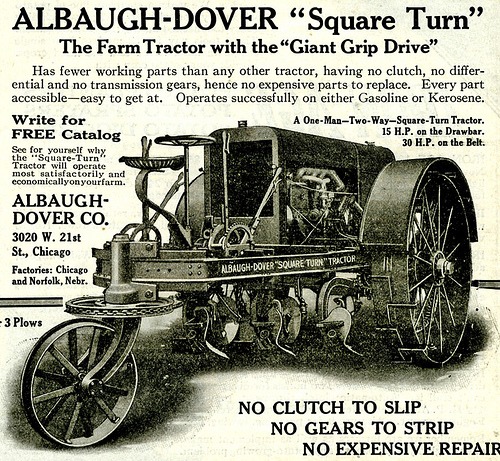Chicago’s large mail order industry didn’t just consist of legendary Sears and Montgomery Ward; many smaller firms also took advantage of Chicago’s transportation hub status and easy access to the hinterlands by locating here. Albaugh-Dover is a prime example.



A 1917 ad for an Albaugh-Dover tractor. Farmers were prominent customers of Chicago mail order firms like Albaugh-Dover. |
While early history on the company is sketchy at best, this is what is known; the firm constructed their factory and warehouse complex on 21st and Marshall Boulevard in 1905, and the main building (at least) was designed by none other than Howard Van Doren Shaw.16 While Shaw is not generally known for his industrial commissions, his major factory design of note is the Lakeside Press complex of RR Donnelley, just north of McCormick Place.
The bird’s eye postcard view (which likely dates to the 1910s) is interesting for two reasons. It shows that the Albaugh-Dover site was once much larger, and consisted of several other buildings which are now gone. Also, it depicts the Douglas Park station of the Douglas “L,” which was of unique design and closed in 1952.17
The Albaugh-Dover plant, ideally located along the Burlington railroad line, manufactured and distributed such diverse products as washing machines, cream separators, gears, pinions, and furniture (according to the postcard). Cream separators (a mechanical device for separating milk from cream) were likely a big moneymaker for Albaugh-Dover, as the 1923 Sanborn fire insurance map shows a whole building in the back dedicated to the manufacture of the devices.18 The company also produced a line of tractors, and even an early car (called a “high-wheel motor buggy”) named the Aldo, around 1910.19
By 1950 the factory had vacated the Marshall Boulevard location, according to Sanborn fire insurance maps. Whether they continued in business elsewhere is unknown. However, as shown in the present day photo, the main building survives in excellent condition and is currently used for lofts.



